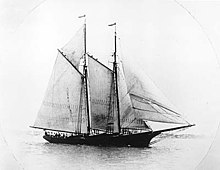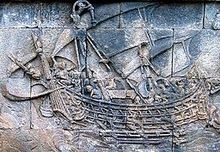Fore-and-aft rig



Afore-and-aft rigis asailingvesselrigwithsailsset mainly along the line of thekeel,rather than perpendicular to it as on asquare riggedvessel.[2]
Description[edit]
Fore-and-aft rigged sails includestaysails,Bermuda riggedsails,gaff riggedsails,gaff sails,gunterrig,lateensails,lug sails,tanja sails,thespanker sailon asquare rigandcrab claw sails.
Fore-and-aft rigs include:
- Rigs with onemast:theproa,thecatboat,thesloop,thecutter
- Rigs with two masts: theketch,theyawl
- Rigs with two or more masts: theschooner
Barquesandbarquentinesare partiallysquare riggedand partially fore-and-aft rigged.
A rig which combines both on a foremast is known as a hermaphroditic rig.
History[edit]
Austronesia[edit]

The fore-and-aft rig is believed to have been first developed independently by theAustronesian peoplessome time around 1500 BC with the invention of thecrab claw sail.It is suggested that it evolved from a more primitive V-shaped "square" sail with two spars that come together at the hull. Crab claw sails spread fromMaritime Southeast AsiatoMicronesia,Island Melanesia,Polynesia,andMadagascarvia the Austronesian migrations.[3]Austronesians in Southeast Asia also later developed other types of fore-and-aft sails, such as thetanja sail(also known as the canted square sail, canted rectangular sail, or the balance lug sail).[3]
Their use later spread into theIndian Oceansince the first millennium, among vessels from theMiddle East,South Asia,andChina.[4][5]
Europe[edit]
The square rig had predominated in Europe since the dawn of sea travel, but in the generally gentle climate of southern Europe and theMediterranean Seaduring the last few centuries before theRenaissancethe fore-and-aft began to replace it. By 1475, its use increased, and within a hundred years the fore-and-aft rig was in common use on rivers and in estuaries in Britain, northern France, and the Low Countries, though the square rig remained standard for the harsher conditions of the openNorth Seaas well as for trans-Atlantic sailing.
The triangularlateensail was more maneuverable and speedier, while the square rig was labor-intense but seaworthy.
References[edit]
- ^Casson, Lionel(1995): "Ships and Seamanship in the Ancient World", Johns Hopkins University Press,ISBN978-0-8018-5130-8,pp. 243–245
- ^Knight, Austin Melvin (1910).Modern seamanship.New York: D. Van Nostrand. pp. 507–532.
- ^abCampbell, I.C. (1995)."The Lateen Sail in World History".Journal of World History.6(1): 1–23.JSTOR20078617.
- ^Hobson, John M.The Eastern Origins of Western Civilisation.Cambridge University Press,2004, p. 58,ISBN978-0-521-54724-6,ISBN0-521-54724-5"
- ^Agius, Dionisius A. (2008).Classic Ships of Islam: From Mesopotamia to the Indian Ocean.BRILL. pp. 141, 160, 211–212, 382.ISBN978-9004158634.

